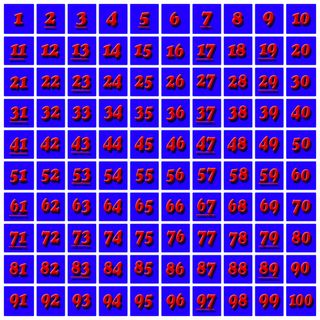What is a Prime Number?

A prime number is an integer, or whole number, that has only two factors — 1 and itself. Put another way, a prime number can be divided evenly only by 1 and by itself. Prime numbers also must be greater than 1. For example, 3 is a prime number, because 3 cannot be divided evenly by any number except for 1 and 3. However, 6 is not a prime number, because it can be divided evenly by 2 or 3.
List of prime numbers
The prime numbers between 1 and 1,000 are:
Largest prime number
The largest prime number discovered so far is 2 raised to the 57,885,161st power minus 1, or 257,885,161 - 1. It is 17,425,170 digits long. It was discovered by University of Central Missouri mathematician Curtis Cooper as part of a giant network of volunteer computers devoted to finding primes.
History of prime numbers
Prime numbers have been studied for thousands of years. Euclid's "Elements," published about 300 B.C., proved several results about prime numbers. In Book IX of the "Elements," Euclid writes that there are infinitely many prime numbers. Euclid also provides proof of the Fundamental Theorem of Arithmetic — every integer can be written as a product of primes in a unique way. In "Elements," Euclid solves the problem of how to create a perfect number, which is a positive integer equal to the sum of its positive divisors, using Mersenne primes. A Mersenne prime is a prime number that can be calculated with the equation 2n-1. [Countdown: The Most Massive Numbers in Existence]

In 200 B.C., Eratosthenes created an algorithm that calculated prime numbers, known as the Sieve of Eratosthenes. This algorithm is one of the earliest algorithms ever written. Eratosthenes put numbers in a grid, and then crossed out all multiples of numbers until the square root of the largest number in the grid is crossed out. For example, with a grid of 1 to 100, you would cross out the multiples of 2, 3, 4, 5, 6, 7, 8, 9, and 10, since 10 is the square root of 100. Since 6, 8, 9 and 10 are multiples of other numbers, you no longer need to worry about those multiples. So for this chart, you would cross out the multiples of 2, 3, 5 and 7. With these multiples crossed out, the only numbers that remain and are not crossed out are prime. This sieve enables someone to come up with large quantities of prime numbers.
But during the Dark Ages, when intellect and science were suppressed, no further work was done with prime numbers. In the 17th century, mathematicians like Fermat, Euler and Gauss began to examine the patterns that exist within prime numbers. The conjectures and theories put out by mathematicians at the time revolutionized math, and some have yet to be proven to this day. In fact, proof of the Riemann Hypothesis, based on Bernhard Riemann's theory about patterns in prime numbers, carries a $1 million prize from the Clay Mathematics Institute. [Related: Famous Prime Number Conjecture One Step Closer to Proof]
Prime numbers & encryption
In 1978, three researchers discovered a way to scramble and unscramble coded messages using prime numbers. This early form of encryption paved the way for Internet security, putting prime numbers at the heart of electronic commerce. Public-key cryptography, or RSA encryption, has simplified secure transactions of all times. The security of this type of cryptography relies on the difficulty of factoring large composite numbers, which is the product of two large prime numbers.
Confidence in modern banking and commerce systems hinges on the assumption that large composite numbers cannot be factored in a short amount of time. Two primes are considered as sufficiently secure if they are 2,048 bits long, because the product of these two primes would be about 1,234 decimal digits.
Prime numbers in nature
Prime numbers even show up in nature. Cicadas spend most of their time hiding, only reappearing to mate every 13 or 17 years. Why this specific number? Scientists theorize that cicadas reproduce in cycles that minimize possible interactions with predators. Any predator reproductive cycle that divides the cicada's cycle evenly means that the predator will hatch out the same time as the cicada at some point. For example, if the cicada evolved towards a 12-year reproductive cycle, predators who reproduce at the 2, 3, 4 and 6 year intervals would find themselves with plenty of cicadas to eat. By using a reproductive cycle with a prime number of years, cicadas would be able to minimize contact with predators.
This may sound implausible (obviously, cicadas don't know math), but simulation models of 1,000 years of cicada evolution prove that there is a major advantage for reproductive cycle times based on primes. It can be viewed here at http://www.arachnoid.com/prime_numbers/. It may not be intentional on the part of Mother Nature, but prime numbers show up more in nature and our surrounding world than we may think.
Related:
Sign up for the Live Science daily newsletter now
Get the world’s most fascinating discoveries delivered straight to your inbox.
